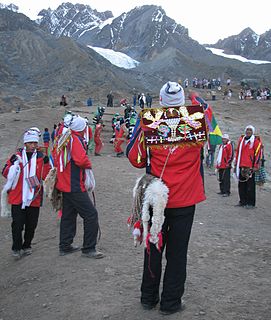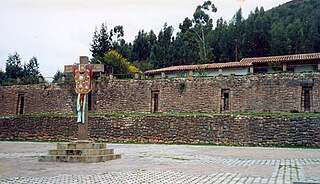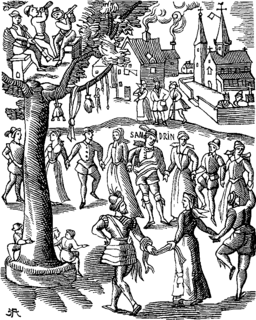
The Inca Empire, also known as the Incan Empire and the Inka Empire, was the largest empire in pre-Columbian America. Its political and administrative structure is considered by most scholars to have been the most developed in the Americas before Columbus' arrival. The administrative, political and military center of the empire was located in the city of Cusco. The Inca civilization arose from the Peruvian highlands sometime in the early 13th century. Its last stronghold was conquered by the Spanish in 1572.

Apurímac is a region in southern-central Peru. It is bordered on the east by the Cusco Region, on the west by the Ayacucho Region, and on the south by the Arequipa and Ayacucho regions. The region's name originates from the Quechua language and means "where the gods speak" in reference to the many mountains of the region that seem to be talking to each other.

The Inti Raymi'rata is a traditional religious ceremony of the Inca Empire in honor of the god Inti, the most venerated deity in Inca religion. It was the celebration of the winter solstice - the shortest day of the year in terms of the time between sunrise and sunset - and the Inca New Year, when the hours of light would begin to lengthen again. In territories south of the equator, the Gregorian months of June and July are winter months. It is held on June 24.

Inti is the ancient Incan sun god. He is revered as the national patron of the Inca state. Although most consider Inti the sun god, he is more appropriately viewed as a cluster of solar aspects, since the Inca divided his identity according to the stages of the sun. Worshiped as a patron deity of the Inca Empire, Pachacuti is often linked to the origin and expansion of the Inca Sun Cult. The most common story says that he is the son of Viracocha, the god of civilization.

Pisac District is one of eight districts of the province Calca in Peru.

Pachamama is a goddess revered by the indigenous people of the Andes. She is also known as the earth/time mother. In Inca mythology, Pachamama is a fertility goddess who presides over planting and harvesting, embodies the mountains, and causes earthquakes. She is also an ever-present and independent deity who has her own self-sufficient and creative power to sustain life on this earth. Her shrines are hallowed rocks, or the boles of legendary trees, and her artists envision her as an adult female bearing harvests of potatoes and coca leaves. The four cosmological Quechua principles – Water, Earth, Sun, and Moon – claim Pachamama as their prime origin. Priests sacrifice llamas, cuy, and elaborate, miniature, burned garments to her. After the conquest by Spain, which forced conversion to Roman Catholicism, the figure of the Virgin Mary became united with that of the Pachamama for many of the indigenous people. In pre-Hispanic culture, Pachamama is often a cruel goddess eager to collect her sacrifices. As Andean cultures form modern nations, Pachamama remains benevolent, giving, and a local name for Mother Nature. Thus, many in South America believe that problems arise when people take too much from nature because they are taking too much from Pachamama. Pachamama is the mother of Inti the sun god and Mama Killa the moon goddess. Pachamama is said to also be the wife of Inti, her son.

Jolljepunco, Colquepunco or Sasahui (sasawi) local name for Leucheria daucifolia, -ni an Aymara suffix to indicate ownership, "the one with the sasawi plant", hispanicized Sasahuini) is a mountain in the Andes of Peru and the name of a lake near the peak. The mountain is about 5,522 metres (18,117 ft) high. It is situated in the northern extensions of the Vilcanota mountain range in the Cusco Region, Quispicanchi Province, in the districts Ccarhuayo and Ocongate and in the Paucartambo Province, Kosñipata District. Jolljepunco lies northwest of the lake Singrenacocha, southeast of Minasnioc. The lake named Jolljepunco is situated south of the mountain at 13°32′04″S71°12′29″W.

Colcampata is an archaeological site in Peru. It is situated in the Cusco Region, Cusco Province, Cusco District.
T'anta Raymi is a religious feast in Peru. It is celebrated annually on October 4th in Oropesa in the Cusco Region, Quispicanchi Province, Oropesa District.

Pikchu is a mountain in the Andes of Peru west of the city of Cusco, about 3,800 metres (12,467 ft) high. It is located in the Cusco Region, Cusco Province, Cusco District.
During the Inca Empire Warachikuy (Quechua) was a ceremony where young men, after undergoing various tests of skill and valor, could receive the official status of an adult man. Today Warachikuy is still an important festival which represents the Andean cultural heritage. The celebrations are held annually at the archaeological site of Saksaywaman near Cusco on the third Sunday of September. They include rites, warlike dances, battles like ch'iyar jaqhi and competitions.
Chukchu is the name of a festival and a satirical dance of the Andes region in Peru. The festival is held annually on August 25 in the Santo Tomás District of the Chumbivilcas Province in the Cusco Region. The dance is performed on festivals dedicated to the patron saints (fiestas patronales) of communities in the provinces of Anta, Canchi, Chumbivilcas, La Convención and Paucartambo. The figures represented in the dance are sick persons, nurses, doctors, assistants and mosquitos.
Pachamama Raymi refers to a methodology for rural development. It was developed in 1988 in Cusco, Peru.
Queshuachaca, consisting of ropes made of grass and spanning the Apurimac River near Huinchiri, in Quehue District, Canas Province, Peru, is the last remaining Inca rope bridge.
Santa Ana is an important archaeological site in the highlands of Ecuador, going back as early as 3,500 BC. It is located in the Palanda Canton, just to the north of its regional capital of es:Palanda, in the Zamora-Chinchipe Province of Ecuador.













